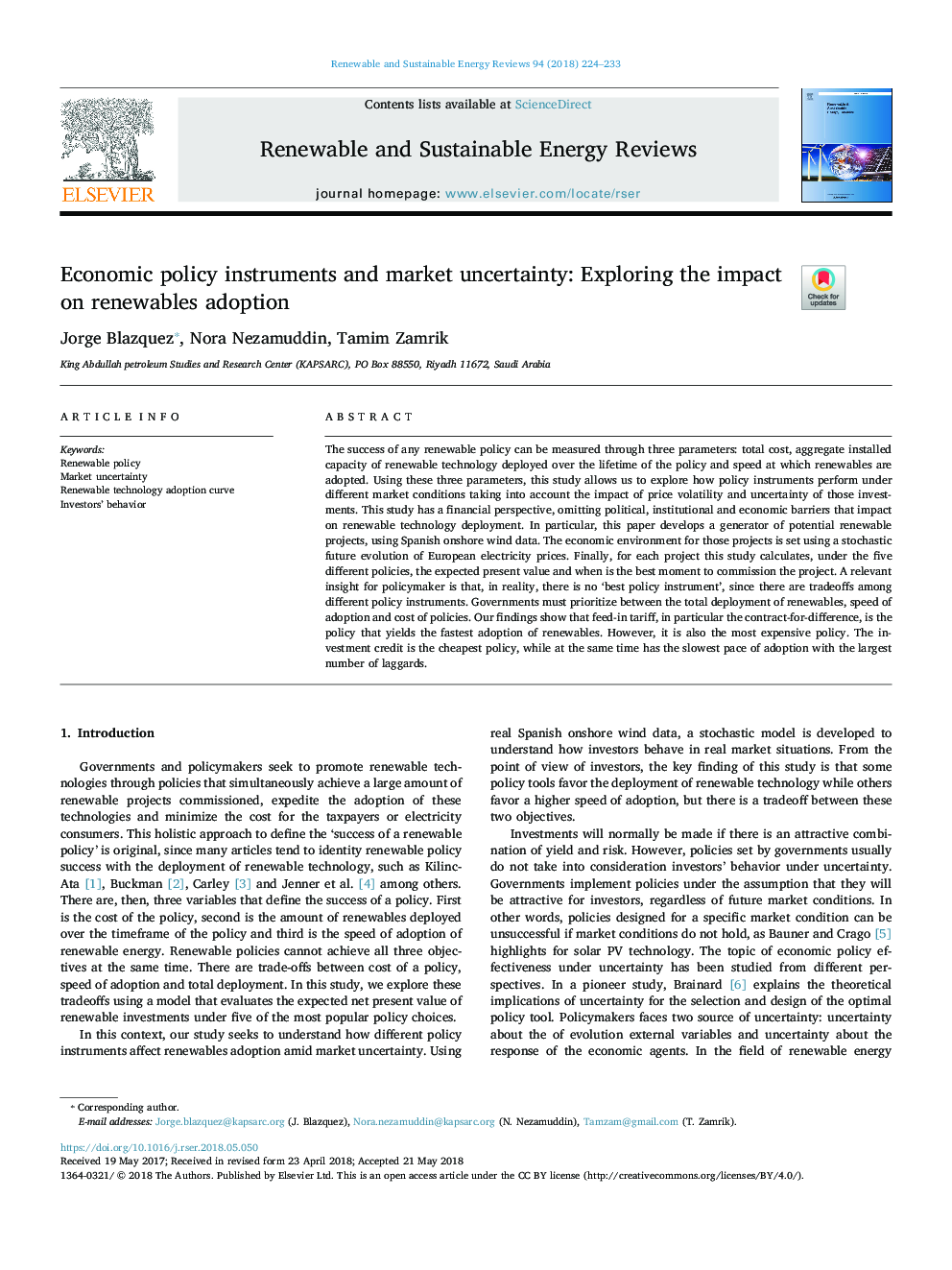| کد مقاله | کد نشریه | سال انتشار | مقاله انگلیسی | نسخه تمام متن |
|---|---|---|---|---|
| 8110400 | 1522290 | 2018 | 10 صفحه PDF | دانلود رایگان |
عنوان انگلیسی مقاله ISI
Economic policy instruments and market uncertainty: Exploring the impact on renewables adoption
ترجمه فارسی عنوان
ابزارهای سیاست اقتصادی و عدم اطمینان بازار: بررسی اثر تأثیرپذیری در انرژی تجدیدپذیر
دانلود مقاله + سفارش ترجمه
دانلود مقاله ISI انگلیسی
رایگان برای ایرانیان
ترجمه چکیده
موفقیت هر گونه سیاست تجدید پذیر را می توان از طریق سه پارامتر: کل هزینه، ظرفیت نصب شده از فن آوری های تجدید پذیر که در طول عمر سیاست و سرعت استفاده از انرژی تجدید پذیر اعمال می شود اندازه گیری شود. با استفاده از این سه پارامتر، این مطالعه به ما اجازه می دهد تا بررسی کنیم که چگونه ابزارهای سیاست در شرایط مختلف بازار عمل می کنند و با توجه به تاثیر نوسانات قیمت و عدم اطمینان این سرمایه گذاری ها. این مطالعه دارای چشم انداز مالی است، و موانع سیاسی، سازمانی و اقتصادی را که بر گسترش فن آوری های تجدید پذیر تأثیر می گذارند، حذف می کند. به طور خاص، این مقاله یک ژنراتور از پروژه های قابل تجدید پتانسیل را با استفاده از داده های باد در دریای اسپانیا توسعه می دهد. محیط اقتصادی برای این پروژه ها با استفاده از یک تئوری تصادفی آینده در قیمت برق اروپا تنظیم می شود. در نهایت، برای هر پروژه، این مطالعه، تحت پنج سیاست مختلف، محاسبه ارزش فعلی انتظار می رود و زمانی که بهترین زمان برای انجام پروژه است. بینش مناسب برای سیاست گذار این است که در واقع، هیچ "بهترین ابزار سیاستگذاری" وجود ندارد، زیرا در میان ابزارهای سیاست متفاوت وجود دارد. دولت ها باید بین استقرار مجدد انرژی های تجدید پذیر، سرعت پذیرش و هزینه سیاست ها اولویت بندی کنند. یافته های ما نشان می دهد که تعرفه خوراک، به ویژه قرارداد برای تفاوت، سیاست است که سریع ترین پذیرش انرژی تجدید پذیر را به ارمغان می آورد. با این حال، این نیز گران ترین سیاست است. اعتبار سرمایه گذاری ارزان ترین سیاست است، در حالی که در عین حال با کمترین سرعت به تصویب رسید با بیشترین تعداد از بازماندگان.
موضوعات مرتبط
مهندسی و علوم پایه
مهندسی انرژی
انرژی های تجدید پذیر، توسعه پایدار و محیط زیست
چکیده انگلیسی
The success of any renewable policy can be measured through three parameters: total cost, aggregate installed capacity of renewable technology deployed over the lifetime of the policy and speed at which renewables are adopted. Using these three parameters, this study allows us to explore how policy instruments perform under different market conditions taking into account the impact of price volatility and uncertainty of those investments. This study has a financial perspective, omitting political, institutional and economic barriers that impact on renewable technology deployment. In particular, this paper develops a generator of potential renewable projects, using Spanish onshore wind data. The economic environment for those projects is set using a stochastic future evolution of European electricity prices. Finally, for each project this study calculates, under the five different policies, the expected present value and when is the best moment to commission the project. A relevant insight for policymaker is that, in reality, there is no 'best policy instrument', since there are tradeoffs among different policy instruments. Governments must prioritize between the total deployment of renewables, speed of adoption and cost of policies. Our findings show that feed-in tariff, in particular the contract-for-difference, is the policy that yields the fastest adoption of renewables. However, it is also the most expensive policy. The investment credit is the cheapest policy, while at the same time has the slowest pace of adoption with the largest number of laggards.
ناشر
Database: Elsevier - ScienceDirect (ساینس دایرکت)
Journal: Renewable and Sustainable Energy Reviews - Volume 94, October 2018, Pages 224-233
Journal: Renewable and Sustainable Energy Reviews - Volume 94, October 2018, Pages 224-233
نویسندگان
Jorge Blazquez, Nora Nezamuddin, Tamim Zamrik,
